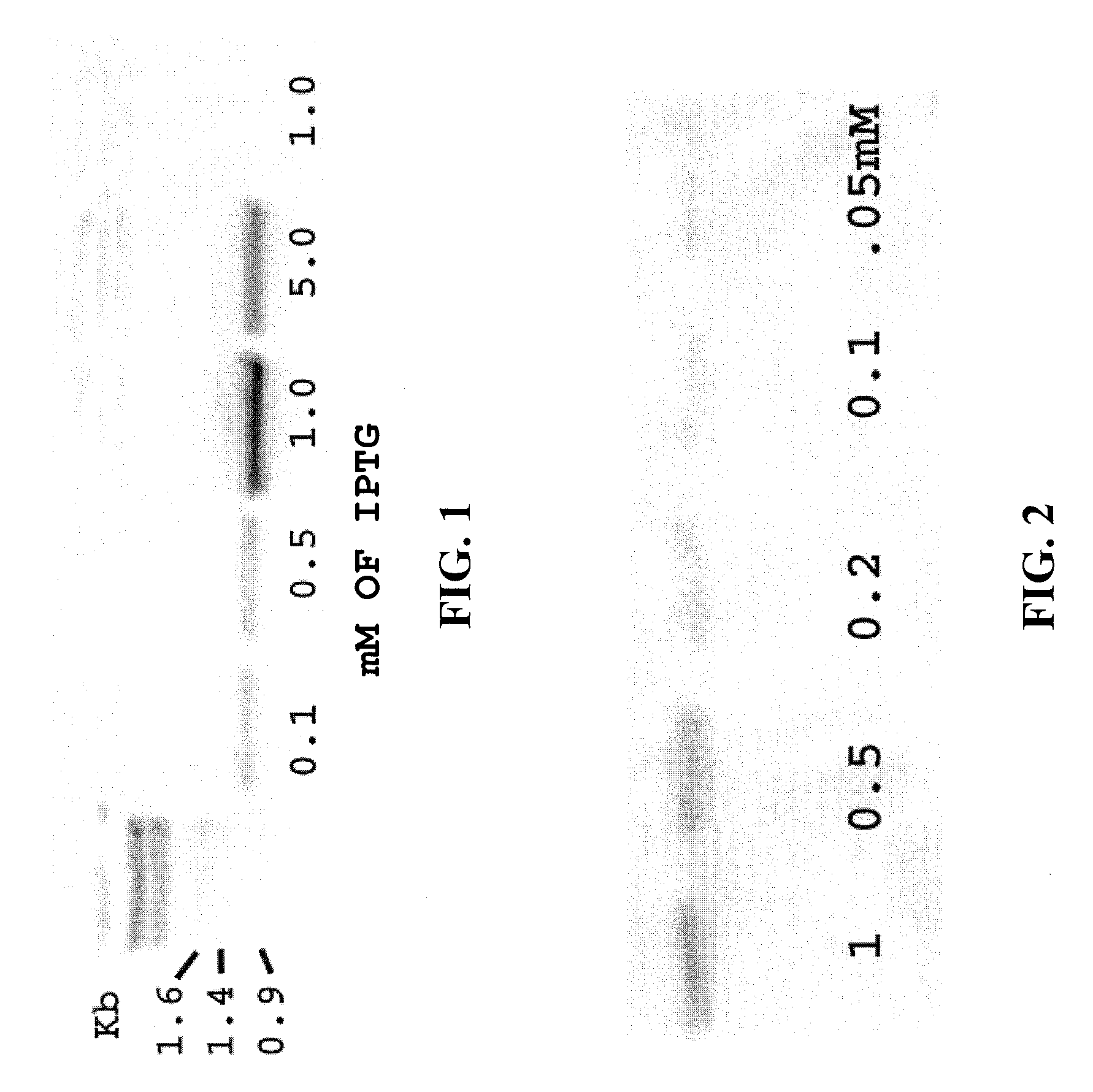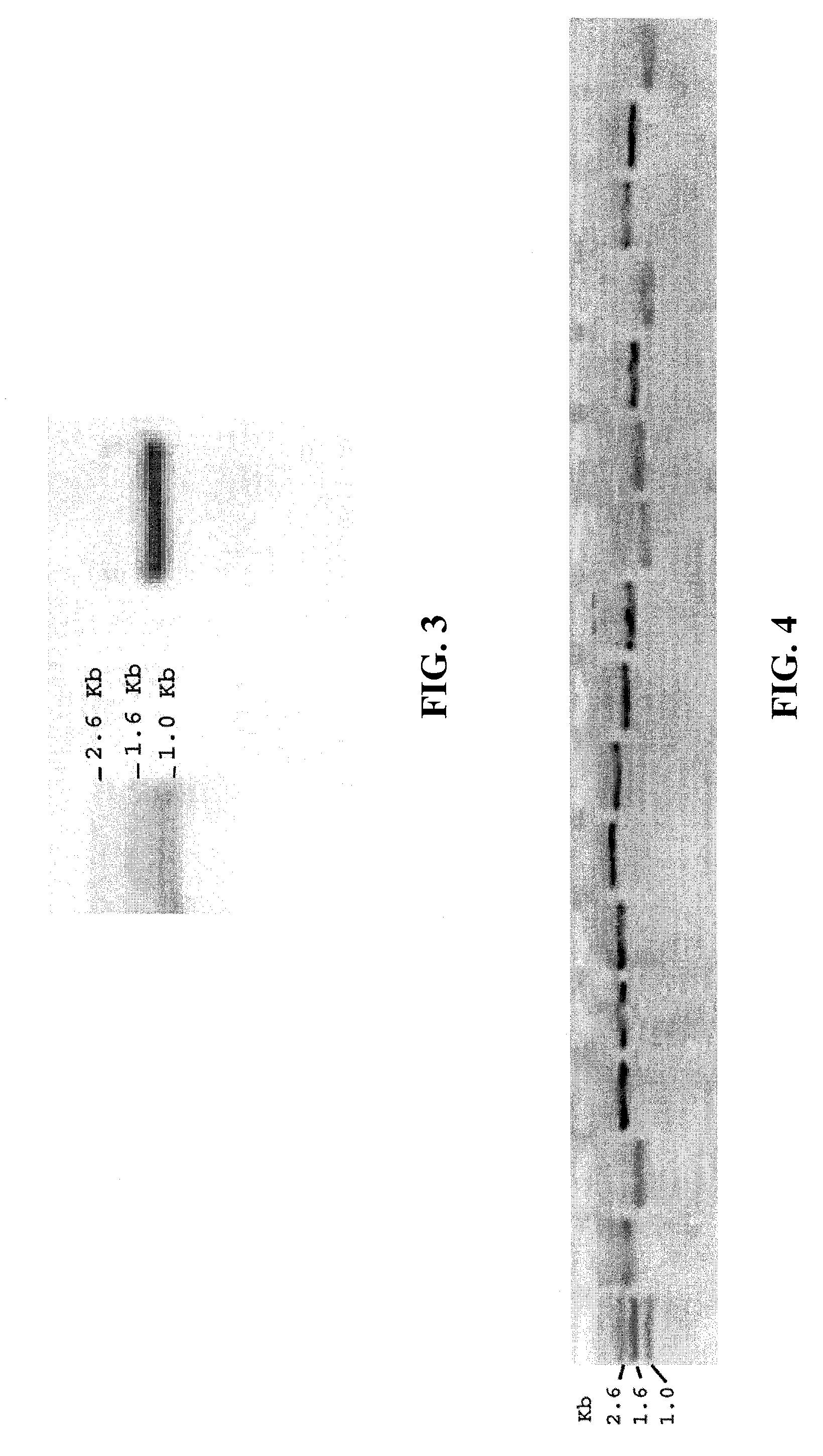Methods of synthesizing polynucleotides using thermostable enzymes
a technology of thermostable enzymes and polynucleotides, which is applied in the field of molecular biology and biotechnology, can solve the problems of substantial increase in the cost and processing steps required to utilize molecular techniques
- Summary
- Abstract
- Description
- Claims
- Application Information
AI Technical Summary
Problems solved by technology
Method used
Image
Examples
example 1
Plasmid-Encoded Thermal Stable Polymerase
[0032]Thermus aquaticus (Taq) DNA polymerase was cloned in pUC18, and co-transfected into host E. coli cells with a separate plasmid encoding a 1.1 Kb J5 target cDNA. Taq expression was induced with 0.1, 0.5, 1, and 5 mM IPTG.
[0033] One to four microliters of overnight host cell bacterial culture was added to a solution containing 10 pmoles each of forward and reverse pUC-derived plasmid-specific primers:
[SEQ ID NO.: 1]5′CGCCAGGGTTTTCCCAGTCACG3′[SEQ ID NO.: 2]5′GAGCGGATAACAATTTCACACAGGAAACAG3′
[0034] The reaction solution also contained 0.2 mM dNTPs and reaction buffer with detergents and DMSO at the following final concentrations: 50 mM Tris HCl, pH 9.2 (25° C.), 16 mM (NH4)2SO4, 2.25 mM MgCl2, 2% (v / v) DMSO, 0.1% (v / v) Tween 20.
[0035] The mixture of bacteria and reaction solution was heated to 80° C. for 20 seconds to denature bacterial proteins, but not the Taq DNA polymerase, and subjected to thermal cycling as follows: 32 cycles of 9...
example 2
Low Copy Plasmid-Encoded Thermostable Polymerase
[0037] The Taq coding sequence was excised from pUC18 with AfIII and XbaI, blunt-ended with T4 DNA polymerase, gel purified, and ligated into the blunted HindIII site of a low copy plasmid, pACYC184, having a p15A origin of replication. The plasmid was transfected into bacteria (E. coli JM109 and DH5α) also containing J5 cDNA in pBS SK-(Stratagene). Screening for polymerase activity was conducted as described in Example 1.
[0038] The results are shown in FIG. 2. Lanes 1-5 show decreasing concentrations of IPTG. Again, amplification of target J5 cDNA was affected by IPTG induction of thermostable polymerase.
example 3
High, Low and Single Copy Expression Vectors Encoding Thermostable Polymerase and Amplification of Resistance Sequences on the Expression Vectors
[0039] A. Construction of expression vectors
[0040] A sequence encoding Taq thermostable polymerase was amplified and cloned into the EcoRI site of pUC18 (ampicillin resistant) under the control of the lacZ promoter. This plasmid was digested using PvuI and TfiI. After digestion, plasmid fragments were blunt-ended with T4 DNA polymerase and purified on a low melting agarose gel. The fragment encoding Taq under the control of the lacZ promoter was ligated in low copy (approximately 40 copies / cell) plasmid pSMART LCKan (kanamycin resistant, Lucigen Corp, Middleton Wis.) and single copy plasmid pSMART VC (chloramphenicol resistant, Lucigen Corp, Middleton Wis.) using T4 DNA ligase in a 10 μl volume containing 25 ng vector DNA and 50 ng insert DNA. Electrocompetent E. coli cells 10G (Lucigen Corp, Middleton Wis.) were transformed with the liga...
PUM
| Property | Measurement | Unit |
|---|---|---|
| pH | aaaaa | aaaaa |
| volume | aaaaa | aaaaa |
| pH | aaaaa | aaaaa |
Abstract
Description
Claims
Application Information
 Login to View More
Login to View More - R&D
- Intellectual Property
- Life Sciences
- Materials
- Tech Scout
- Unparalleled Data Quality
- Higher Quality Content
- 60% Fewer Hallucinations
Browse by: Latest US Patents, China's latest patents, Technical Efficacy Thesaurus, Application Domain, Technology Topic, Popular Technical Reports.
© 2025 PatSnap. All rights reserved.Legal|Privacy policy|Modern Slavery Act Transparency Statement|Sitemap|About US| Contact US: help@patsnap.com



